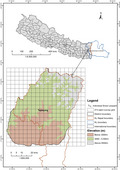- Record: found
- Abstract: found
- Article: found
No silver bullet? Snow leopard prey selection in Mt. Kangchenjunga, Nepal

Read this article at
Abstract
In this study, we investigated the impact of domestic and wild prey availability on snow leopard prey preference in the Kangchenjunga Conservation Area of eastern Nepal—a region where small domestic livestock are absent and small wild ungulate prey are present. We took a comprehensive approach that combined fecal genetic sampling, macro‐ and microscopic analyses of snow leopard diets, and direct observation of blue sheep and livestock in the KCA. Out of the collected 88 putative snow leopard scat samples from 140 transects (290 km) in 27 (4 × 4 km 2) sampling grid cells, 73 (83%) were confirmed to be from snow leopard. The genetic analysis accounted for 19 individual snow leopards (10 males and 9 females), with a mean population size estimate of 24 (95% CI: 19–29) and an average density of 3.9 snow leopards/100 km 2 within 609 km 2. The total available prey biomass of blue sheep and yak was estimated at 355,236 kg (505 kg yak/km 2 and 78 kg blue sheep/km 2). From the available prey biomass, we estimated snow leopards consumed 7% annually, which comprised wild prey (49%), domestic livestock (45%), and 6% unidentified items. The estimated 47,736 kg blue sheep biomass gives a snow leopard‐to‐blue sheep ratio of 1:59 on a weight basis. The high preference of snow leopard to domestic livestock appears to be influenced by a much smaller available biomass of wild prey than in other regions of Nepal (e.g., 78 kg/km 2 in the KCA compared with a range of 200–300 kg/km 2 in other regions of Nepal). Along with livestock insurance scheme improvement, there needs to be a focus on improved livestock guarding, predator‐proof corrals as well as engaging and educating local people to be citizen scientists on the importance of snow leopard conservation, involving them in long‐term monitoring programs and promotion of ecotourism.
Abstract
The genetic analysis accounted for 19 individual snow leopards (10 male and 9 female) with a mean population size estimate of 24 (95% CI: 19–29), and an average density of 3.9 snow leopards/100 km 2 within 609 km 2. From the available prey biomass, we estimated snow leopards consumed 7% annually which was comprised of wild prey (49%), domestic livestock (45%), and 6% unidentified items. The estimated 47,736 kg Blue sheep biomass gives a snow leopard‐Blue sheep ratio of 1: 59 on a weight basis. The proportion of young Blue sheep was estimated at 17%, with an almost double predation rate at 28%.
Related collections
Most cited references62
- Record: found
- Abstract: not found
- Article: not found
A Technique for Analysis of Utilization-Availability Data
- Record: found
- Abstract: not found
- Book: not found
Model Selection and Multimodel Inference
- Record: found
- Abstract: found
- Article: not found
